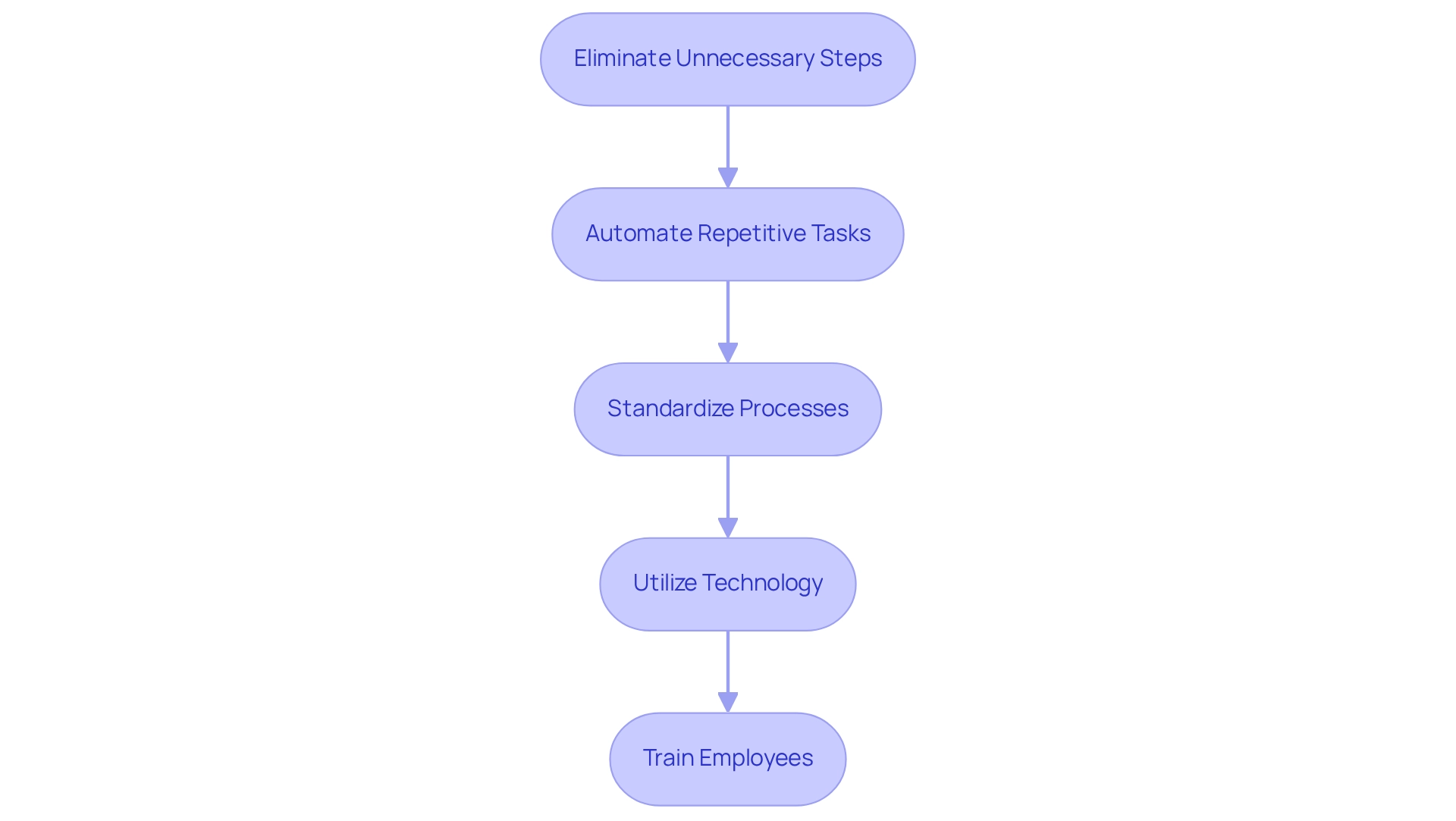
Overview
You might be wondering how streamlining your workflow can make a difference. Well, it turns out that enhancing operational efficiency is all about simplifying and optimizing processes. This can lead to significantly quicker task completion times and even boost employee satisfaction!
For instance, imagine reducing the time it takes to generate an insurance quote from 14 days down to just 4 minutes. Pretty impressive, right?
The article shares strategies for assessing and adapting workflows, helping you eliminate those pesky bottlenecks and ensure continuous improvement.
Now, let’s dive into how you can start making these changes!
Key Highlights:
- Workflow streamlining involves simplifying and optimizing processes to enhance efficiency and productivity in organizations.
- Automation can significantly reduce task completion times, exemplified by the insurance industry's quote generation time dropping from 14 days to just 4 minutes.
- Improving processes can lead to higher employee satisfaction by allowing teams to focus on meaningful work.
- 45% of business teams are involved in automation efforts, highlighting the importance of collaboration.
- Successful case studies, like Feathery for client onboarding, demonstrate effective workflow automation.
- To assess current workflows, organizations should map existing processes, gather data, identify bottlenecks, engage stakeholders, and document findings.
- 40% of organizations are investing in AI-powered Business Process Management (BPM) solutions, reflecting a growing trend in workflow optimization.
- Implementing optimization strategies includes eliminating unnecessary steps, automating repetitive tasks, standardizing processes, utilizing technology, and training employees.
- Setting performance metrics and conducting regular reviews are crucial for evaluating and adapting workflows effectively.
- Gathering feedback from team members helps identify areas for improvement in workflows.
- Documenting changes ensures all team members are aware of current procedures and facilitates future optimization efforts.
Introduction
In the fast-paced world of business, you might be wondering: why is efficiency so crucial? Well, it's no longer just a nice-to-have—it's a must! More and more organizations are catching on to the idea that streamlining workflows can significantly boost productivity and cut down on mistakes. By simplifying processes and automating those pesky repetitive tasks, companies not only save precious time but also enhance employee satisfaction and make better use of their resources.
And with technology advancing at lightning speed—especially in areas like AI and machine learning—the quest for optimal workflows is more important than ever. So, let’s dive into some key strategies for assessing, implementing, and continually refining your workflows. This article is packed with insights that can help propel your organization toward operational excellence!
Understand Workflow Streamlining
You might be wondering what streamlining the workflow really means. Well, it’s all about simplifying and optimizing processes to boost efficiency and productivity in organizations. This means spotting and eliminating unnecessary steps, automating those repetitive tasks, and making sure each process is as straightforward as possible. By putting these strategies into action, companies can cut down on delays and reduce errors, leading to a noticeable improvement in operational performance.
The perks of process optimization are pretty impressive. For instance, did you know that automation can save a ton of time? In the insurance industry, quote generation time dropped from 14 days to just 4 minutes! This not only ramps up productivity but also frees up employees to focus on more strategic, value-added activities instead of getting bogged down with mundane tasks.
And there’s more! Enhancing processes can actually boost employee satisfaction, too. When teams are freed from those repetitive duties, they can dive into more meaningful work, which helps create a motivated workforce. In fact, recent findings show that 50% of business leaders are looking to automate even more repetitive tasks within their companies. It’s clear that there’s a growing recognition of the importance of process optimization.
Let’s not forget about collaboration. About 45% of business teams are playing key roles in building automation, highlighting the need for teamwork in this area.
Successful case studies really bring these principles to life. Different sectors have jumped on to streamline workflows, boost productivity, and cut down on mistakes. Take client onboarding, for example—tools like Feathery have made collaboration on forms and e-signatures a breeze, resulting in .
As Rita Lazar-Tippe, Chief Digital Officer, pointed out, "Our loan origination requirements were too custom for typical LOS tools, but Feathery was able to meet those standards while allowing us to launch 5x faster than building in-house."
Looking ahead to 2025, we can expect the trend of embracing process automation to pick up speed, thanks to advancements in AI and machine learning. Understanding how to streamline workflows and the benefits it brings is crucial for any organization, especially for operations managers eager to implement effective improvements and achieve operational excellence. So, are you ready to dive into this exciting journey?
Assess Current Workflows
To effectively evaluate your current processes, you might be wondering what steps to take. Let’s break it down:
- Map Existing Processes: Start by using flowcharts or diagrams to create a visual representation of your workflows. This method makes it easier to see the order of tasks and helps you spot any redundancies. Streamlining your workflow boosts visibility and efficiency.
- Gather Data: Collect both quantitative and qualitative data on each process. Focus on metrics like time taken, resources used, and outcomes achieved. This data is key for understanding performance and finding areas to improve.
- Identify Bottlenecks: Take a close look at your processes to find stages where delays happen or tasks pile up. You might notice signs like long wait times, frequent rework, or missed deadlines—these can really slow you down.
- Engage Stakeholders: Involve your team members who are part of these processes during the evaluation. Their insights can reveal pain points and opportunities for improvement that might not be obvious at first. Plus, collaboration among leadership, employees, and even external consultants is crucial for effective BPM implementation. Good communication and training can help maximize benefits.
- Document Findings: Make sure to record your observations and insights systematically. This organized documentation will serve as a handy reference for future optimization efforts, ensuring everyone is on the same page about the current state of workflows.
By following these steps, you can streamline your workflow and enhance mapping effectiveness, leading to improved operational efficiency and happier customers. Did you know that 40% of organizations are currently investing in AI-powered Business Process Management (BPM) solutions? This shows a growing recognition of the importance of . And get this—low-code technology is expected to make up over 70% of management applications, up from under 25% in 2020. Talk about technological progress!
Now, let’s dive into how integrating SowFlow's instant documentation capabilities can simplify this process. With SowFlow, your teams can whip up user guides effortlessly, ensuring documentation is always up-to-date and accessible. This not only boosts knowledge sharing but also helps with onboarding and standardization, ultimately leading to better outcomes for your organization.
By leveraging SowFlow's solutions, your teams can efficiently update and revise documentation, tackling challenges through careful planning and execution. This significantly enhances the chances of successful BPM implementation. So, are you ready to take your documentation to the next level?
Implement Optimization Strategies
Once you've taken a good look at your current processes, let's dive into some optimization strategies that can really make a difference.
You might be wondering, how can I streamline my workflow?
- Eliminate Unnecessary Steps: Start by reviewing your outlined procedures. Identify and cut out any steps that don’t add value. By trimming the fat, you can really enhance efficiency.
Now, let's talk about Automating Repetitive Tasks. Have you considered using automation tools for routine tasks like data entry, notifications, and reporting? By automating these processes, your team can shift focus to more strategic initiatives, potentially saving up to 360 hours a year! For example, a case study in supply chain management shows that professionals are optimistic about automation, recognizing its potential to improve retention and upskill employees.
Now, onto the next point:
- Standardize Processes: It’s a good idea to develop standard operating procedures (SOPs) for tasks that come up regularly. This not only ensures consistency but also reduces the risk of errors, creating a more reliable operational environment. Interestingly, 64% of respondents in enterprise organizations are looking to develop technologies that enhance employee experience, highlighting the importance of standardization. With tools like SowFlow, you can easily create SOPs and training resources right in your browser, saving precious time and enhancing user experience.
Speaking of tools, let’s
- Utilize Technology: Implementing can really boost collaboration and communication among your team members. Take Snowplow, for instance—it’s been called a game changer in documentation, helping users optimize their workflows effectively. is also great for tracking progress and managing tasks, which can lead to better productivity.
Finally, don’t forget to
- Train Employees: Investing in training for your team on new processes and tools is crucial. Ensuring everyone is on the same page with the revised processes is key for effective execution and maximizes the benefits of optimization. By using user-friendly tools like SowFlow, teams can simplify documentation and enhance productivity, ultimately transforming their operational efficiency.

Evaluate and Adapt Workflows
To keep your workflows running smoothly and even boost their efficiency, let’s dive into some practical evaluation and adaptation steps:
- : First off, think about what key performance indicators (KPIs) you want to track. These should reflect how effective your workflows really are. Metrics like time savings, error rates, and employee satisfaction can paint a clear picture of your business health. For example, organizations using AI-based route optimization have seen their on-time delivery (OTD) rate jump to 98%, highlighting just how much technology can impact operational efficiency.
- Conduct Regular Reviews: Now, it’s crucial to schedule regular check-ups on your processes. How are they performing against those metrics you set? These assessments can help you spot new bottlenecks or inefficiencies that need addressing. As McKinsey puts it, "By systematically collecting and analyzing data, metrics provide valuable insights into the performance, quality, and efficiency of software projects, leading to higher quality outcomes."
- Gather Feedback: Don’t forget to ask your team for their thoughts! Their firsthand experiences are gold when it comes to understanding what’s working well and what needs a little TLC.
- Adapt to Changes: Staying agile is key! Modify your processes as business conditions change—think technological advancements, market shifts, or organizational changes. Automation can really help here, making it easier to track performance metrics and ensuring you’re monitoring things in real-time. This is essential for keeping efficiency alive in a fast-paced environment.
- Document Changes: Lastly, keep a solid record of any changes you make. This way, everyone on your team knows what the current procedures are and can refer back to earlier versions if needed.
Regular workflow evaluations are a must for success. By consistently collecting and analyzing performance data, you’ll gain valuable insights into your processes, leading to better quality and efficiency. Companies that effectively use metrics often see significant improvements in their operational outcomes.
For instance, a case study on Kanban metrics shows that active measurement can boost efficiency, cut lead times, and increase throughput. Plus, organizations embracing automation in performance tracking enjoy real-time monitoring, which reduces manual effort and enhances overall productivity.
If you’re looking to further streamline your workflow and enhance operational efficiency, consider reaching out to Show low. Our innovative solutions in documentation and knowledge management can help you create instant user guides and implement user-friendly tools just for you. Contact us today to discover how we can assist you in optimizing your processes!
Conclusion
Streamlining workflows is such a key strategy for organizations looking to boost efficiency and productivity in today’s fast-paced business world. You might be wondering how this works, right? By getting a grip on workflow optimization principles, taking a good look at current processes, and putting in place some smart strategies, companies can really cut down on delays and errors. Plus, it’s a win-win for employee satisfaction! The evidence is pretty clear: automation and solid process management not only save time but also let teams focus on more valuable tasks.
As we look ahead, integrating advanced technologies like AI and machine learning is going to be a game-changer in driving these improvements. By nurturing a culture of collaboration and continuous improvement, businesses can keep their workflows flexible and ready to adapt to changing demands. Remember, the journey toward operational excellence isn’t just a one-off project; it’s an ongoing commitment to refining processes and boosting performance.
So, in closing, chasing optimal workflows is essential for any organization that wants to thrive in a competitive landscape. By putting efficiency first, investing in automation, and keeping those communication lines open, organizations can unlock their full potential and build a more productive and happy workforce. Embracing these strategies today will set the stage for success tomorrow!
Frequently Asked Questions
What does streamlining the workflow mean?
Streamlining the workflow means simplifying and optimizing processes to enhance efficiency and productivity in organizations by eliminating unnecessary steps and automating repetitive tasks.
How does process optimization improve operational performance?
By implementing process optimization strategies, companies can reduce delays and errors, leading to a significant improvement in operational performance.
Can you provide an example of time saved through automation?
In the insurance industry, the time required for quote generation was reduced from 14 days to just 4 minutes through automation, significantly increasing productivity.
How does process optimization affect employee satisfaction?
Process optimization can enhance employee satisfaction by freeing teams from repetitive tasks, allowing them to engage in more meaningful work and fostering a motivated workforce.
What percentage of business leaders are looking to automate more tasks?
Recent findings indicate that 50% of business leaders are seeking to automate additional repetitive tasks within their companies.
How important is collaboration in process automation?
Collaboration is essential in process automation, with about 45% of business teams playing key roles in building automation solutions.
Can you give an example of a successful case study in process automation?
An example is client onboarding, where tools like Feathery have streamlined collaboration on forms and e-signatures, resulting in a more efficient onboarding experience.
What did Rita Lazar-Tippe say about process automation?
Rita Lazar-Tippe noted that Feathery met their custom loan origination requirements and enabled them to launch 5 times faster than building in-house.
What trends can we expect in process automation by 2025?
By 2025, the trend of embracing process automation is expected to accelerate due to advancements in AI and machine learning.
Why is understanding workflow streamlining important for operations managers?
Understanding how to streamline workflows and the benefits it brings is crucial for operations managers who aim to implement effective improvements and achieve operational excellence.
👍
What others are liking
5 Steps to outline your ideal documentation structure
5 MINS READ
Where to start the your journey of mapping out your ideal documentation structure, aligning it with the very heartbeat of your organization?
Defining a winning level of detail in your process
3 MINS READ
What is too much detail, and what is too little? This article described in that winning level detail about what detail is enough.





